Looking to get well off the beaten track in Cambodia? Travelfish (and Cambodia) regular Greg McCann reports on a fascinating trek into a little-known national park set in the far northeast of this ravaged country. McCann is so fond of the park in fact that together with some friends he formed Habitat ID, which works to garner more attention for "paper parks" -- those that are parks in name but get little protection in reality.
A veteran wildlife conservationist in Southeast Asia recently called me Mr Virachey, saying I'd earned the title by insisting on returning to Cambodia's Virachey national park for the fifth year in a row, rather than take up his sweet offer to help me work on a project in Thailand. That would be the project where, last year, we heard a tiger roaring in the jungle together just 100 metres from our camp. Instead, I opted to return to Virachey for a trip that was much more than just a trek.
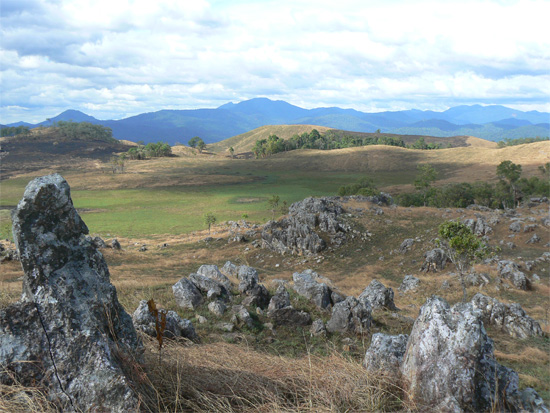
Veal Thom grasslands.
We spent 13 days in the jungle installing 11 motion-triggered camera traps in remote areas of the park in an effort to produce evidence that tigers (which are possibly locally extinct) or even Javan rhinoceros remain in the area. Locals insist that the latter hang on in small numbers in the sacred mountains that form a natural barrier between Cambodia and Laos, but the last known Javan rhino in mainland Southeast Asia was poached for its horn in Vietnams Cat Tien national park in 2011. We are also hoping to get images of leopards, clouded leopards, elephants, gaurs, and -- who knows? -- maybe even the near-mythical kouprey, one of the most mysterious large mammals. Thats how still-unexplored some areas of Virachey are today.
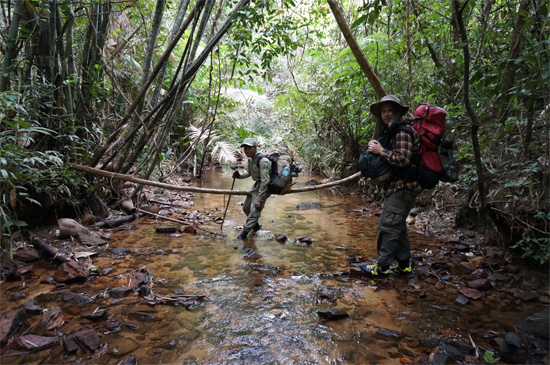
An unnamed tributary of the Gan Yu.
Snakes were the main threat to our safety -- we ate a dead reticulated python that had recently been killed by an eagle and floated headless down to the shore of our camp one morning on the Gan Yu River. Ticks, hornets, leeches and mosquitoes were also a concern, but none proved to be any trouble.
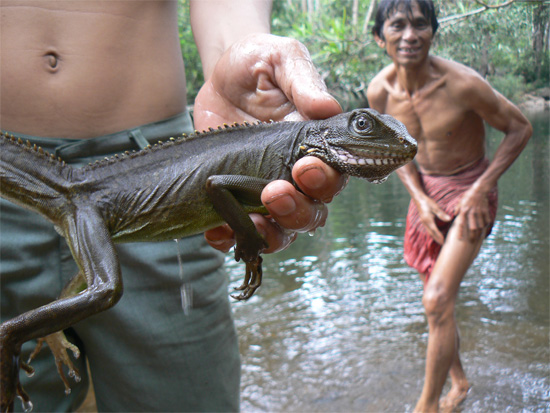
Chinese Water Dragon.
The night before we left our Brao village on the Sesan River, I inquired about another threat: the tek-tek or Annamite Mountain Yeti. Called the Batutut by Vietnamese tribal people, both the Vietcong and US Special Forces claim to have seen and fired on them during the war, and nearly everyone I talked to in the villages knew about them. With their machete-like forearms, the tek-tek can decapitate a man with one swing. I met a Brao man who was an authority on the tek-tek, and I asked him if one would attack a group of nine of us (our group comprised three barangs and six locals). He contemplated the question. After a minute of pondering, he lifted his head and said: In that situation, two of you will die, and the rest will survive.
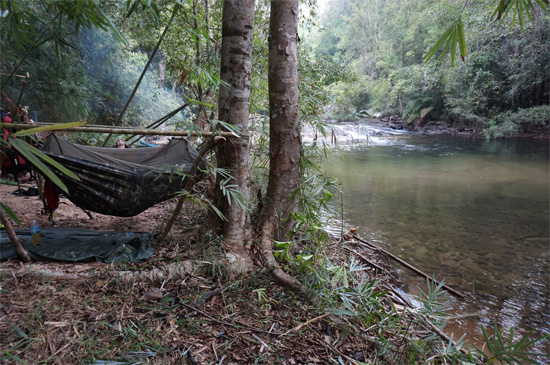
D'dar Poom Chop camp.
We didnt encounter the tek-tek, but we did hear two sun bears engaged in a ferocious fight (or were they fornicating?) just 400 metres from the Laos border, we found elephant footprints, dhole tracks, heard loads of gibbons, saw hornbills, and found so many sun bear claw marks in the forests north of the Veal Thom grasslands that we feel the area might be called the Upper Gan Yu River Sun Bear Preserve.
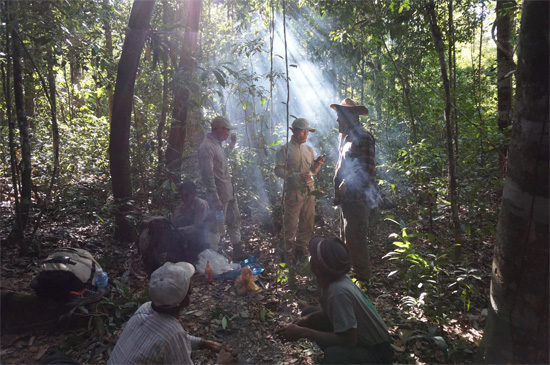
A jungle meeting.
But this is more than a trip report: we need your help. In August 2012 some friends and I formed a group called Habitat ID. Our mandate is to go into neglected paper parks -- those that get little real protection -- in Southeast Asia, and set up cameras to prove that they are worth being treated like real parks, which get sufficient protection from loggers and poachers. Virachey is our first project.
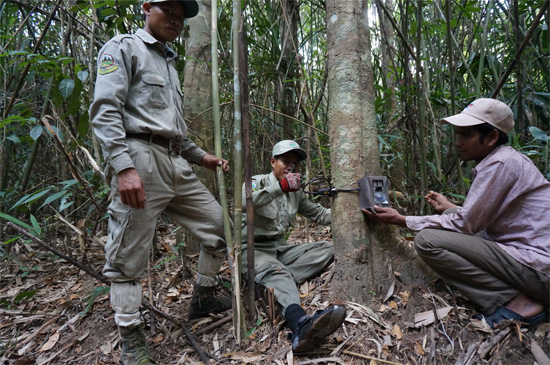
Rangers setting a trap.
How can you help? As an ecotourist! If you trek to the Veal Thom Grasslands (a jaw-dropping natural savanna in the middle of the jungle) you can give Park Ranger Sou Soukern the opportunity to service four of our cameras, which are set up near permanent swamps, wallowing holes, and game trails. Having checked on camera-traps myself in Thailand, I can tell you that taking those memory cards out of the traps and sticking them in your camera to see what kind of wildlife has been photographed will add excitement to your trip. And youll know that you are also furthering the conservation cause in this beautiful but highly threatened park.
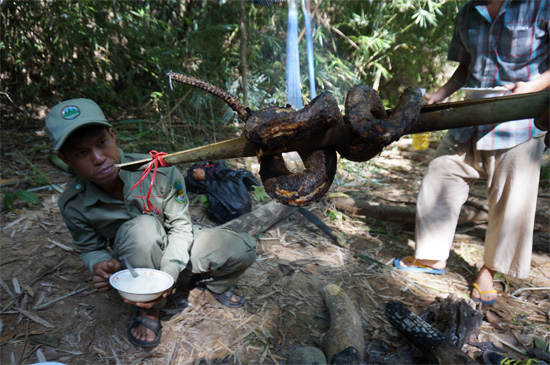
Python for breakfast.
Theres also a new trek connected to the classic Veal Thom Grasslands trip. Instead of spending the night in grasslands itself, you can pass through and then head into the northern forests (where only a handful of outsiders have ever been) and camp out at a serene waterfall swimming hole on the Gan Yu River known as Ddar Poom Chop. The swimming is unreal, and youll also be able to service another camera, where just after three nights we got images of a large civet cat.
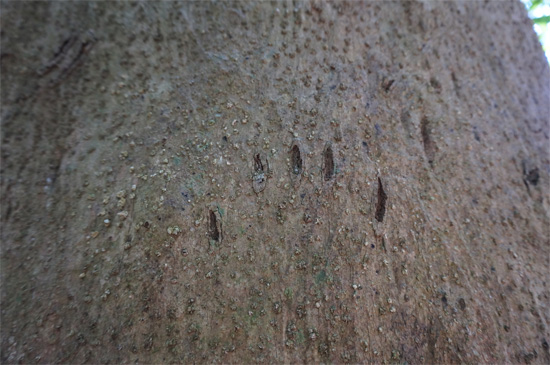
Sunbear woz here.
The Veal Thom Grasslands is unique in Southeast Asia -- it's an inexplicable savannah that, according to Brao legends, was once the home of giants. You can help ensure that todays giants of the forests -- elephants, tigers, leopards (and tek-teks) -- will always have a home in Virachey by doing a camera trap-checking trek to Veal Thom.
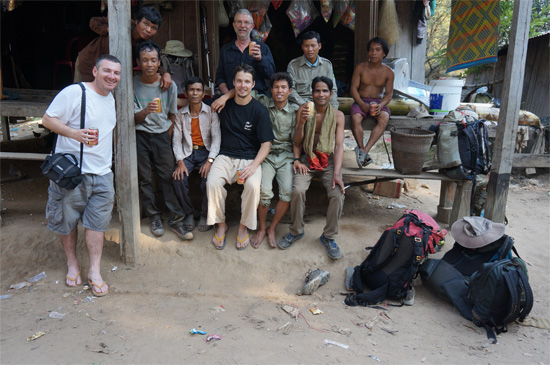
Another trek in the bag.
The best time to visit is from late November till late April and the price usually works out to about $50 per person per day, which includes food, hammock rental, boat ride, and village home-stays at the beginning and end of the trek. A moderate to strong level of fitness is required for this trek.
Those interested should contact Park Ranger Sou Soukern at +855 9733 34775 or on Facebook at: https://www.facebook.com/sou.soukern. Or email me at greg.mccann1@gmail.com.